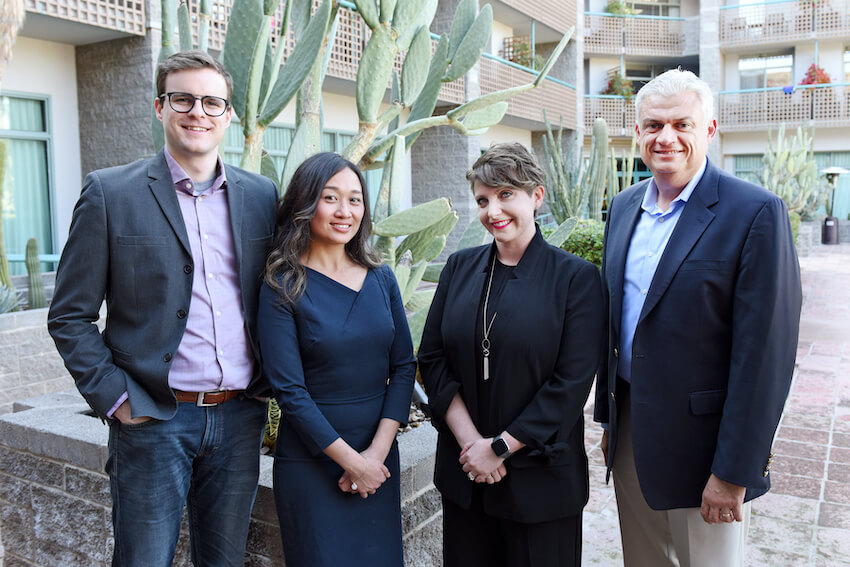2020 CAAE Fellows Recap
By Gabrielle Korn | April 21, 2020 | in Insights | 0 comments
L to R: Adam Sylvain, Patricia Chau Nguyen, Katie Sampson and Jorge Ancona (UC Riverside), Chair, CAAE Awards & Fellowships Committee
Share this post!
The 2020 CAAE Winter Institute featured the Fellows presentations earlier in the program to allow for the widespread participation by members – and the Fellows did not disappoint.
Robert G. Forman Fellow, Patricia Chau Nguyen (UCLA), was first in line to present her research on Native American interactions with University Advancement. Her studies revealed that Native American and other diverse alumni “love their degrees, but did not love their student experiences.” As such, alumni relations professionals cannot rely on the strength of nostalgia to engage this cohort as with other alumni, and need to create new forms of engagement delivered at the appropriate time and place where diverse alumni are more apt to reconnect with their alma mater.
“There was a data deficiency for Native American alumni and it's a group that really hasn't gotten a lot of attention,” Patricia said. “This community really deserved that kind of intentional thought, in terms of how we want to engage with them. I'm grateful for the fellowship for giving me that headspace to study this.”
Patricia also noted that she appreciated having time to sit with Native American alumni without having “an agenda present other than hearing their stories. That meaning can sometimes be lost in our profession,” she said, “as we try to build positive nostalgia and positive memories for our alumni. It’s okay to be in a place where things may not ever get better for a particular population.”
She acknowledged the importance of reflecting on one’s own position when exploring these sensitive topics. “What makes a Native American community so unique is their intentional and meaningful connection to their land,” she said. “I found myself reflecting back to my own experiences. My family are refugees who fled the Vietnam War. There is no sense of homeland per se for my family, because my family doesn't feel like Vietnam is their country anymore.” When she returns to campus, Patricia is planning to host UCLA’s first ever Native American reunion this spring and is looking forward to her ongoing support of this community.
Next in line, Jerry F. Tardy Fellow, Katie Sampson (Temple), looked at the Life Stage Models proposed by Daniel Levinson to categorize young alumni at her institution into two camps, those in pre-adulthood (22-28 years) and those in transition to adulthood (28-33 years). She found that mirroring consumer business models to engage young alumni according to their life stage needs results in greater retention and connection to the institutional brand.
Temple established a cross-functional team of life stage leads, each with clear objectives and key outcomes. “The fellowship program was an exciting opportunity that afforded me the ability to think further outside the box to translate best practices from industry leaders outside higher education to help define ‘better’ practices to target alumni,” said Katie. “I was surprised by the number of correlations and recommendations that I was able to make that require reframing the mindset, business models and organizational structures that are not traditionally in place within alumni relations shops.” Since completing her research, Katie is now serving on a cross-functional committee at Temple to pilot a new Lifetime Value Model, focusing on the constituencies between the ages 31-39.
Finally, Lawrence S. Preo Fellow, Adam Sylvain (UChicago), explored the means by which numerous universities tracked the success of their online alumni engagement programs. The plethora of online opportunities is on the rise, but these digital communities require our attention and response. While questions remain regarding the impact of online programming and its efficacy in driving alumni to increase their engagement and philanthropy, Adam reported that online engagement is generally less expensive than other forms of engagement and generally yields very positive interactions between alumni and alma mater.
“Not only did I discover that online alumni engagement was top of mind for many alumni leaders, but there was a universal understanding that nobody has the online engagement space completely figured out,” said Adam. His research included interviews with staff from 11 public and private US-based universities. “I discovered a lot of successful programs highlighted in my research, but every institution had questions to ask and challenges to overcome in thinking about how they want to do online engagement better,” he concluded.
All three Fellows expressed that their CAAE fellowships had been a professional highlight.
“I’m truly grateful for the opportunity,” said Adam. “It has certainly reaffirmed the work that I’m doing at the University of Chicago and furthered my own conviction that talented alumni and advancement teams, aided by good data, can do tremendous work to engage their alumni constituents.”
According to Katie, “The fellowships was one of the most impactful professional development opportunities and experiences that I have had so far in my seven years in higher education! The feedback and support that I received from the CAAE representatives at the Winter Institute after my presentation helped to validate my role within the alumni relations space, and further motivates me to continue this research and make meaningful contributions to help strengthen and elevate the field of alumni relations.”
Patricia had some advice to share with the 2021 cohort of Fellows: take the opportunity to explore a non-traditional topic, as the Fellowship program provides a great deal of built-in support. In her own words, “Lean into it!”
By Molly Ritvo, freelancer
With Gabrielle Korn (McGill)

0 comments
Leave a comment